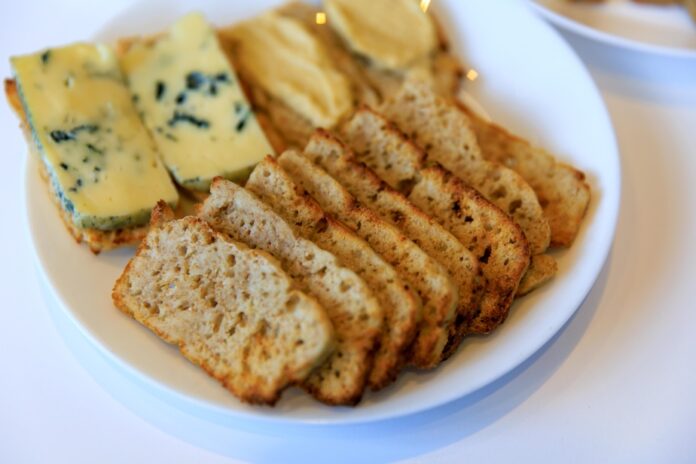In many families, the ham sandwich is a lunch staple. But sliced ham is expensive per kilo. Johanne St-Cyr, from Montreal, buys the whole ham, cooks it, and uses it in several recipes. “I eat it first in slices, with potatoes, and I separate the rest: one part will go for the ham lasagna with béchamel, another will go for the fried rice, a few slices for the croque-monsieur, and I chop the rest for sandwiches,” she explains.
Do you feel like you’re going to skyrocket the price of your Saturday morning pancakes when you add vanilla extract? Anne-Marie Grenier, from Lac-Supérieur, has the solution: she makes her own vanilla extract. We macerate vanilla pods in rum for at least two months, and that’s it. “After comparing prices for a small bottle of vanilla, you’ll be convinced,” she says. The Épices de cru team recommends a ratio of five vanilla pods to 250 ml of vodka or rum.
Making jams can seem tedious, with Mason jars, sterilization and huge quantities of fruit, but Isabelle Charbonneau, from Saint-Jérôme, opts for simplicity. She uses wilted fruits she has on hand (apples, berries, stone fruits) and mixes them, in equal parts, with frozen strawberries, frozen blueberries or rhubarb from her garden. “I simmer everything for 10 minutes with a tablespoon of maple syrup per cup of fruit,” she explains. Then, she lightly pounds everything. “When it’s cooled, if it’s too runny, I add ground chia seeds, about a tablespoon per cup and a half,” she says. She makes her jams in small quantities and keeps the rest in small jars in the freezer.
Jacynthe Huard, from Saint-Denis-sur-Richelieu, has more than one trick up her sleeve to save money: use what she already has, modify the recipe, freeze, cook seasonally… And one of her recipes combines all that: his panini bread. She was inspired by Ricardo’s pizza dough and schiacciata – a Tuscan flatbread – to create her own recipe. She uses it to make sandwiches (with whatever is lying around in the fridge and cupboards), toast, and even as a base for pizzas. “It’s a very versatile bread,” which keeps well in the freezer. Discover his recipe in the next tab.
Sylvaine Tétreault, from Granby, accumulates her vegetable scraps and peelings in a Ziploc bag, which she keeps in the freezer: celery section, parsley stem, asparagus stalk, carrot, onion and parsnip peels… When the bag is full, she pours everything into a cauldron, covers with water, and lets it simmer. Result ? A delicious vegetable broth, which she uses to cook her rice and couscous, and as a base for soups.
Cooking in a microwave oven is a concept that dates from another era. “But this one, believe me, it works,” says Montrealer Marie Trudel about her recipe for no-knead English muffin bread… in the microwave. Marie Trudel found this recipe around twenty years ago on the Fleischmann yeast website. She uses it to make sandwiches, garlic croutons, canapes and toast. “Like an English muffin, the slices must be put in the toaster to be eaten, with the characteristic crunch of the edges and toasted cells,” she says. Instead of using regular milk in the recipe, she uses powdered milk, which is more affordable. She buys her yeast by the pound, and stores it in the freezer. She presents her recipe to us in the following tab.
Cooking hummus yourself saves a lot of money, and even more so when using dried chickpeas. This is what Jean Courtois, from Danville, in Estrie, does. He soaks the chickpeas for six to eight hours, in a large volume of water, in the refrigerator, rinses them, then boils them for about 30 minutes in salted water. “Peas are done when they squish between two fingers,” he says. Her hummus recipe combines a two-pound (907g) bag of dried chickpeas, 310ml water, 310ml olive oil, 180ml lemon juice, 120g sesame butter, two heads roasted garlic, salt and pepper. He purees all the ingredients in a food processor, and that’s it. Hummus keeps well in the freezer.
What Laurie-Anne Pilon-Lutfy can’t cook, she learns to do. This is how the Montrealer started making her own energy bars, her breakfast cookies, but also her granola. Talk to any home economics master: you save a lot by making your own granola. Laurie-Anne Pilon-Lutfy set her sights on a chai-spiced granola recipe from the blog Gimme Some Oven, stuffed with nuts and sweetened with honey (and therefore more expensive), but you can find an even more economical recipe.
For this last suggestion, we were the ones who contacted Geneviève Leblanc, from Sainte-Julie. For four years now, she has been preparing her kombucha every Wednesday. Geneviève made several trials and errors to arrive at her current recipe, based on the recipe offered on the RISE company website. Its two secret ingredients? Hibiscus and rosehip herbal tea and grapes from your garden. She gives us her recipe in the next tab.
Here are three recipes from our readers to help reduce your grocery bill.
Recipe by Marie Trudel, formerly offered on the Fleischmann website
Prep: 5 minutesCook: 9 minutesRest: 48 minutesYield: 16 slices
To store the bread, Marie Trudel cuts it into 16 slices, lightly toasts them, then keeps them in the freezer in an airtight dish. “When I need my two pieces of toast in the morning, I toast them again,” she says.
For a “brioche” version of this bread, you can add 1/3 cup of raisins, the zest of an orange and 2 tbsp. teaspoon of cinnamon.
Recipe inspired by pizza dough from the Ricardo website and Tuscan schiacciata bread
Prep: 10 minutes Rest: 2 hours Cook: 12 minutes Yield: 4 panini loaves
Recipe by Geneviève Leblanc, inspired by the Rise recipe
Preparation: 45 minutesFermentation: 7 days 48 hoursYield: 6 liters
*If you don’t have Scoby mushrooms (the mother of kombucha), make them following the recipe steps on the Rise website.
















































